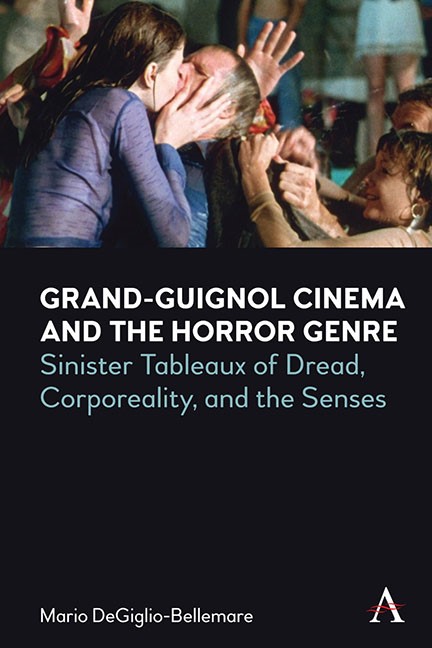Book contents
- Frontmatter
- Dedication
- Contents
- Miscellaneous Frontmatter
- Introduction: Grand-Guignol Cinema and the Senses: Eyes Without a Face, Attractions, Affect and Facial Trauma
- Chapter One The Grand-Guignol Theatre: A Short History of theTheatre and Spatial Ecologies of Dread The Hitch-Hiker and Shivers
- Chapter Two Grotesque Carnivals of “Stubborn” Aurality: Embodied Discourse in Early Talkie Horror Cinema Murders in the Rue Morgue, Freaks, and The Black Cat
- Chapter Three The Sight of Corpses in the Ruins of Modernity: Surgical Sadists under Censorship: The Body Snatcher, and Mad Love, The Blood of the Beasts
- Chapter Four Erotic Abattoirs of Bad Taste: Unproductive Potlatch in Exploitation Cinema: Fascination, Grapes of Death, and Salò, or 120 Days of Sodom
- Chapter Five French Colonial Skinning: Affect and Becoming-Wound in the Cinema of Sensation: Trouble Every Day, Sombre, and In My Skin
- Conclusion: Drag Performativity and Multisensorial Dread Blood and Black Lace and Psycho
- Bibliography
- Index
Introduction: Grand-Guignol Cinema and the Senses: Eyes Without a Face, Attractions, Affect and Facial Trauma
Published online by Cambridge University Press: 15 November 2023
- Frontmatter
- Dedication
- Contents
- Miscellaneous Frontmatter
- Introduction: Grand-Guignol Cinema and the Senses: Eyes Without a Face, Attractions, Affect and Facial Trauma
- Chapter One The Grand-Guignol Theatre: A Short History of theTheatre and Spatial Ecologies of Dread The Hitch-Hiker and Shivers
- Chapter Two Grotesque Carnivals of “Stubborn” Aurality: Embodied Discourse in Early Talkie Horror Cinema Murders in the Rue Morgue, Freaks, and The Black Cat
- Chapter Three The Sight of Corpses in the Ruins of Modernity: Surgical Sadists under Censorship: The Body Snatcher, and Mad Love, The Blood of the Beasts
- Chapter Four Erotic Abattoirs of Bad Taste: Unproductive Potlatch in Exploitation Cinema: Fascination, Grapes of Death, and Salò, or 120 Days of Sodom
- Chapter Five French Colonial Skinning: Affect and Becoming-Wound in the Cinema of Sensation: Trouble Every Day, Sombre, and In My Skin
- Conclusion: Drag Performativity and Multisensorial Dread Blood and Black Lace and Psycho
- Bibliography
- Index
Summary
A woman wakes up drowsily on an operating table. Her eyes widen as she looks around furtively. She has been prepped for an operation: surgical clamps dangle from her head dressing, and she bears a dotted-line marking around her face detailing a pathway for the surgeon’s blade. She makes an initial attempt to get up, but finds that she is strapped to the surgical table. The increasing awareness of her shocking situation causes Paulette (Béatrice Altariba) to whimper as she struggles harder to free herself. Freedom may be the goal here, as she twists and writhes, seeking escape, but the quiet proximity of the camera to her face, the rustling of surgical fabric, the precision tracing inscribed on her skin, provoke a tactile response in the audience somewhere in between the surface of her bound body and the freedom that lies presumably beyond the camera frame. The film cuts to the face of a woman, staring from behind an uncanny white mask. The mask is blank but spectral—even ghastly—but also oddly benevolent, obscuring the emotions and intentions of the woman behind it. The woman behind the white mask in a surgical setting above is of course from the final scene of Georges Franju’s Eyes Without a Face/Les Yeux sans Visage (1960). Much has been written about the woman’s stare behind the mask, as eyes are often perceived as a “window to the soul,” but this is not only a film about eyes. It is a film about skin, or about skinning in fact as the film forcefully shows in an earlier gory moment of surgical trauma. Docteur Génessier (Pierre Brasseur) obsessively skins young women in order to fix the disfigurement of his daughter Christiane (Edith Scob) caused by a car crash for which he is responsible. The film decidedly brings together hints of incest with surgical torture in a thematic, affective and sensorial universe of what I will call in this post-representational study “Grand-Guignol cinema.”
Masking is not a novelty of horror cinema as it cuts across many movements and traditions, both literary and cinematic, but in Grand-Guignol cinema it is often linked to disfigurement.
- Type
- Chapter
- Information
- Grand-Guignol Cinema and the Horror GenreSinister Tableaux of Dread, Corporeality and the Senses, pp. 1 - 24Publisher: Anthem PressPrint publication year: 2023

